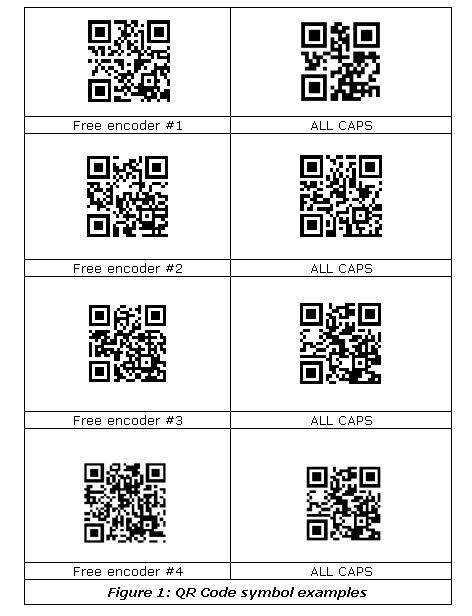Bar Codes: QR Should Not Mean "Questionable Readability"
 There are right ways and wrong ways to implement QR Codes. Do you know the difference?
There are right ways and wrong ways to implement QR Codes. Do you know the difference?
Without question, QR Code is the 2D symbology of choice for business-to-consumer and social media. QR Code symbols are appearing in magazines, newspapers, on print ads, brochures, flyers and even billboards and television. They're also showing up on business cards for business-to-business applications.
Two major factors contributing to the popularity of QR Codes are the availability of free encoders (and smart mobile device decoders) and a rapidly-expanding number of clever, branded symbols and applications that make these images "ultra cool".
So what could possibly go wrong?
Only one thing really: The production of unusable symbols. But this could result from a number of causes: variations in encoders, poorly-produced "branded" symbols, bad printing/lack of verification, enigmatic symbols, and variations in the quality of decoders/cameras.
Poor Encoders
A lot of people are taking advantage of free online encoders. But not every QR Code encoder is a good one. As the examples in figure 1 illustrate, there is considerable variation among them.
Figure 1 shows symbols created by four different free, online QR Code encoders. No evaluation was performed when selecting the online encoders other than picking the first four that came up on a web search for "free QR Code encoders". [Different search engines will yield different results so no inference can be drawn as to the identities of these websites.]
Each symbol generator was directed to encode, http://www.aimglobal.org For comparison, the URL was also encoded in all caps: HTTP://WWW.AIMGLOBAL.ORG.
Note the variations in the symbols. In only one instance (encoders #3 and #4; all caps) were the resulting symbols the same.
Encoders 3 and 4 are somewhat special cases. The all lower-case symbols are different because of differences in the error correction (EC) level used, encoding mode and data masking pattern used by the encoder. For the all caps version, Encoders 3 and 4 do produce the same symbols.
However, Encoders 1 and 2 used the same EC level for the lower-case URL so should have produced identical symbols. The difference between the symbols is likely the result of different encoding modes and data masking patterns.
With all caps, only Encoders 1 and 4 took advantage of the fact that QR Code is optimized for all caps and, as a result, produced smaller symbols (or allowed for a larger module size in the same area). It should also be noted that browsers today infer "http://" when they encounter "www." in a character string and, thus, can be omitted from the encoded data. This was not tested but might have resulted in smaller symbols (larger module size) with all encoders.
Despite the differences, all symbols did decode correctly. These were "pristine" symbols and had not suffered any degradation or damage. As the verification report in Table 1 shows, some symbols were more robust than others (received a higher ANSI/ISO grade) and would be able to tolerate more damage than others.
Authored by Bert Moore -
Bert Moore was a 25+ year veteran of the Automatic Identification and Data Collection (AIDC) industry and a recognized expert on the subject.
He was the director of IDAT Consulting & Education and served under contract as AIM's director of technical communications and media relations. In addition to writing and editing AIM's "RFID Connections" and "AIM Connections" newsletters, he served as the recording secretary for AIM's Technical Symbology Committee (TSC) and RFID Experts Group (REG).
Bert was a member of the ANSI Data Identifier maintenance committee and the AIM RFID Emblem maintenance committee. He chaired the CompTIA RFID+ Certification cornerstone committee.
Moore was a 1992 recipient of the AIM USA "Industry Service Award", was selected as a charter member of the AIDC 100 organization in 1997, and was the 2010 recipient of the AIM "Excellence in Journalism" Award.
Unfortunately, Bert passed away in the summer of 2012. He was an invaluable asset to the bar code world, and always ready to answer a question. On several occasions The Bar Code News reached out to him for technical advice and he never failed to respond immediately. His passing is a loss to the whole AIDC community.
About AIM
Since 1972, AIM has actively led the way in industry standards, education, and outreach.
AIM is the international trade association representing automatic identification and mobility technology solution providers. Through the years, industry leaders continue to work within AIM to promote the adoption of emerging technologies.
AIM actively supports the development of AIM standards through its own Technical Symbology Committee (TSC), Global Standards Advisory Groups, and RFID Experts Group (REG), as well as through participation at the industry, national (ANSI) and international (ISO) levels.
AIM is the leading authority on:
* Bar code,
* Radio frequency identification (RFID), and
* Enterprise mobile computing.
AIM members are also leading solutions providers of:
* Voice systems,
* Magnetic stripe,
* Mobile computing,
* OCR, and
* Contact memory.
AIM delivers accurate and unbiased information on AIM technologies, standards, and applications. Through support of the Education and Public Policy Committee (EPP), AIM is able to provide an unbiased technology perspective to legislators, media and consumers.
Click here to view AIMGLOBAL.ORG
Reprinted with permission.
